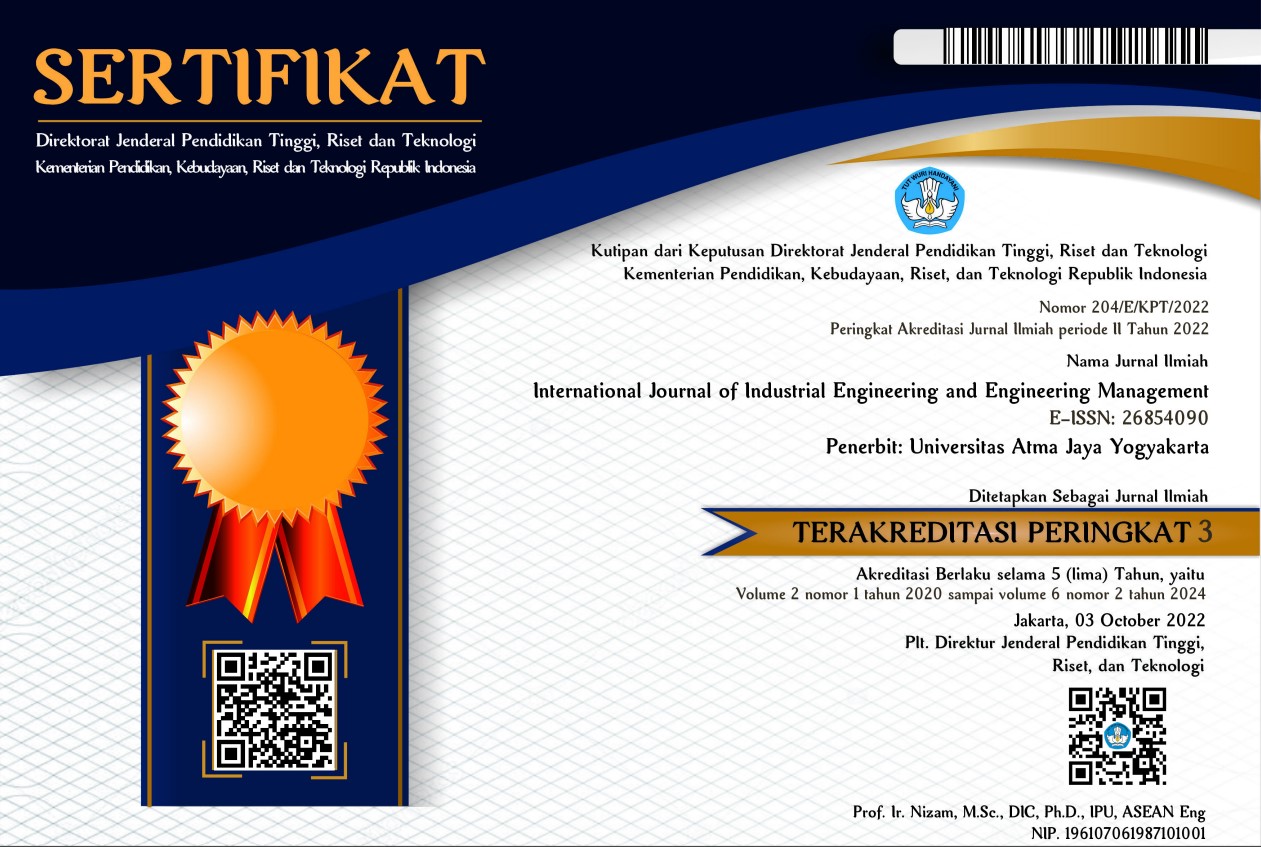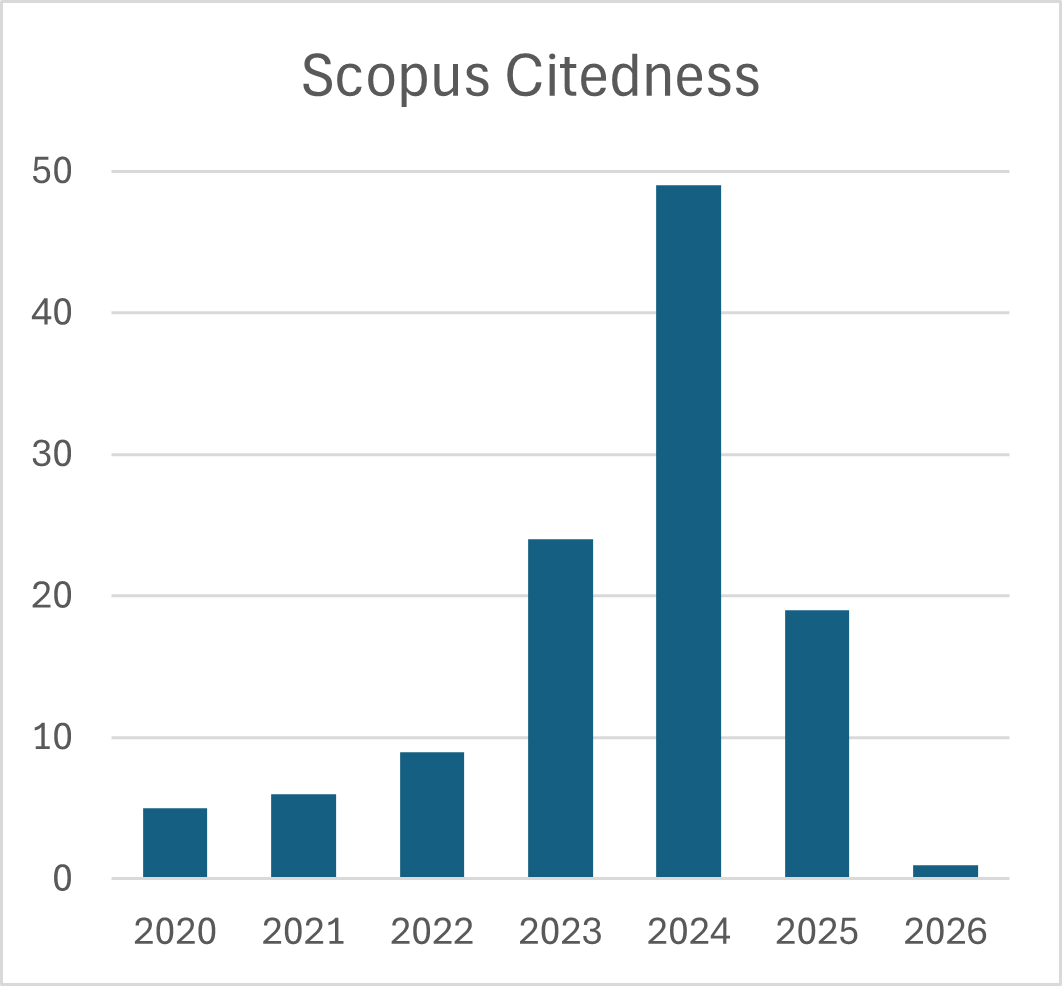
Author Guidelines
BEFORE YOU START
Publications Ethics
International Journal of Industrial Engineering and Engineering Management (IJIEEM) Publication Ethics are based on Committee on Publication Ethics( COPE)’s Best Practice Guidelines for Journal Editors from COPE’s website.
Duties of Author:
Reporting Standards:
Authors should present an accurate account of the original research performed as well as an objective discussion of its significance.
Researchers should present their results honestly and without fabrication, falsification or inappropriate data manipulation.
A manuscript should contain sufficient detail and references to permit others to replicate the work. Fraudulent or knowingly inaccurate statements constitute unethical behavior and are unacceptable.
Manuscripts should follow the submission guidelines of the journal.
Originality and Plagiarism:
Authors must ensure that they have written entirely original work.
The manuscript should not be submitted concurrently to more than one publication unless the editors have agreed to co-publication.
Relevant previous work and publications, both by other researchers and the authors’ own, should be properly acknowledged and referenced.
The primary literature should be cited where possible.
Original wording taken directly from publications by other researchers should appear in quotation marks with the appropriate citations.
Multiple, Redundant, or Concurrent Publications:
Author should not in general submit the same manuscript to more than one journal concurrently.
It is also expected that the author will not publish redundant manuscripts or manuscripts describing same research in more than one journal.
Submitting the same manuscript to more than one journal concurrently constitutes unethical publishing behavior and is unacceptable.
Multiple publications arising from a single research project should be clearly identified as such and the primary publication should be referenced
Acknowledgement of Sources:
Authors should acknowledge all sources of data used in the research and cite publications that have been influential in determining the nature of the reported work.
Proper acknowledgment of the work of others must always be given.
Authorship of the Paper:
The authorship of research publications should accurately reflect individuals’ contributions to the work and its reporting.
Authorship should be limited to those who have made a significant contribution to conception, design, execution or interpretation of the reported study. Others who have made significant contribution must be listed as co-authors.
In cases where major contributors are listed as authors while those who made less substantial, or purely technical, contributions to the research or to the publication are listed in an acknowledgement section.
Authors also ensure that all the authors have seen and agreed to the submitted version of the manuscript and their inclusion of names as co-authors.
Disclosure and Conflicts of Interest:
All authors should clearly disclose in their manuscript any financial or other substantive conflict of interest that might be construed to influence the results or interpretation of their manuscript.
All sources of financial support for the project should be disclosed.
Fundamental Errors in Published Works:
If the author discovers a significant error or inaccuracy in the submitted manuscript, then the author should promptly notify the journal editor or publisher and cooperate with the editor to retract or correct the paper.
Hazards and Human or Animal Subjects:
The author should clearly identify in the manuscript if the work involves chemicals, procedures or equipment that have any unusual hazards inherent in their use.
PREPARE YOUR MANUSCRIPT
Manuscript Requirement
It is important for the author(s) to read and follow the guidelines below before submitting your manuscript.
|
Format |
Article files should be provided in Microsoft Word format only. |
|
Article length / word count |
Articles should be between 4000 and 10000 words in length including abstract, references, table and figure explanation, and appendices. Please provide explanation for each figure or table. |
|
Article title |
A concisely worded title should be provided. |
|
Author details |
The names of all contributing authors should be listed in the manuscript. Please list them in the order in which you would like them to be published. The information about author is as follows: · Author email address (institutional preferred). · Author name. We will reproduce it exactly, so any middle names and/or initials they want featured must be included. · Author affiliation. This should be where they were based when the research for the paper was conducted using the following format; affiliation, country name. ALL authors that have made a significant contribution to the paper are listed. Those who have provided support but have not contributed to the research should be featured in an acknowledgements section. In addition, you should never include people who have not contributed to the paper or who do not want to be associated with the research. |
|
Research funding |
All sources of external research funding should be put in the acknowledgements section. |
|
Structured abstract |
All submissions must include abstract that contain the brief explanation of the conducted research including: Purpose, Design/methodology/approach/framework, Findings, and Originality.The maximum length of your abstract should be 250 words in total, including keywords and article classification. |
|
Keywords |
Your submission should include up to 6 appropriate and short keywords that capture the principal topics of the paper. The list of keywords is provided in the submission system. During the process, we may replace some of them with matching terms to ensure consistency across publications and improve your article’s visibility. |
|
Article classification |
You will be asked to select a type for your paper; the options are listed below. If you don’t see an exact match, please choose the best fit: · Research Paper · Case Study · Review paper Research paper Research paper reports on any type of research undertaken by the author(s), including: · Model development · The construction or testing of a framework or method · Testing of data · Empirical research · Scientific research · Papers with a practical focus Case study Case study represent the implementation, experiences and in-depth analysis of framework and or method within organizations. The findings that makes certain framework or method can be applied either in general case or spesific case must be discussed in this type of the research. Literature review This category may aim to cover the main contributors to the development of a topic and explore their different views. In addition, this type pf research synthesize previous researches on certain research area. |
|
Organization of the article |
In general, for Research Paper and Case Study Paper types of research should include an introduction and a comprehensive literature review sections. A comprehensive literature review is able to show gap analysis. Therefore the contributions of the research presented in the article both on theoretical development or practical application of certain methods can be clearly seen. Please note that on certain cases, introduction and literature review can be included in the introduction section when gap analysis is stated explicitly. After introduction and/or literature review sections the organization of the article may vary depending on the type of research. Suggested sections for Research Paper paper after the introduction and or literature review part: · Research methodology or proposed method/framework or Model development · Numerical example, or case study to illustrate the applicability of the proposed method/framework, or Analysis · Results/Findings and Discussion · Conclusion · References · Appendices Suggested sections for Case Study Paper after the introduction and or literature review: · Case description · Findings and Discussion · Conclusion · References · Appendices Suggested sections for Literature Review Paper: · Introduction · Review Methodology · Review Results and Discussion · Conclusion · References · Appendices |
|
Headings |
Headings must be concise, with a clear indication of the required hierarchy. |
|
Figures |
· Beside picture, graph and flowchart can be considered as figure. · Every figure must be titled. The title of the figure is placed below the figure and should be in the same page with the figure itself. It should be typed using bold letter, font Times New Roman 10 pt. Please capitalize only the first word of each sentence except for conjunction and preposition without full stop (.). · The figure number must be written using Arabic style. · The spacing between the title of the figure and the first line of the next paragraph is one (1)- spaced with paragraph spacing-after 6pt. · If the page orientation is landscape than the title of the figure is placed in the right side of the page.If the size of the figure is so big that it cannot be put in one page, then the the figure can be placed in the appendices. |
|
Tables |
· Horizontal and vertical border is only used to separate between header and content of the table. It is no need to use inside horizontal border. · Header should be typed using bold letter, font Times New Roman 10 pt. · The title of the table should be placed above the table if the page orientation is portrait. If the page orientation is landscape than the title of the table is place in the left side of the page. Please capitalize only the first word of each sentence except for conjunction and preposition. · The table number must be written using Arabic style · The spacing between the table title and the title is one (1)-spaced with paragraph spacing-after 6 pt. · The spacing between last line of paragraph and the table title is one (1)-spaced with paragraph spacing-after 6pt. · If the table needs more than one page, then it can be split to two or more table. However, for each continued table please give the title: Cont’d. This should be aligned left margin. If the size of the table is so big that it cannot be put in one page, then the table can be placed in the appendices. |
|
References |
All references in your manuscript must be formatted using the APA styles. Please ensure you check all your citations for completeness, accuracy and consistency. References to other publications in your text should be written as follows: · Single author: (Astanti, 2006) · Two authors: (Ai and Astanti 2006) · Three or more authors: (Ai et al., 2006) Please note, ‘et al' should always be written in italics. A few other style points. These apply to both the main body of text and your final list of references. · When referring to pages in a publication, use ‘p.(page number)’ for a single page or ‘pp.(page numbers)’ to indicate a page range. · Page numbers should always be written out in full, e.g. 175-179, not 175-9. · Where a colon or dash appears in the title of an article or book chapter, the letter that follows that colon or dash should always be lower case. · When citing a work with multiple editors, use the abbreviation ‘Ed.s’. At the end of your paper, please supply a reference list in alphabetical order using the style guidelines below. Where a DOI is available, this should be included at the end of the reference. |
|
For books |
Surname, Initials. (year). Title of book: Subtitle in italics (#ed). Publisher. e.g. Ross, S.M. (2010). Introduction to Probability Models. Academic Press. |
|
For book chapters |
Chapter Author Surname, Initial(s). (year_. Title of chapter. In Editor Initial(s). Editor Surname (Ed.), italics (#ed., pp. chapter page range). Publisher Name. e.g. Kim, R. (2005). Incremental quantity discount. In B. Rudy & H. Dion (Eds.), Inventory Management (pp. 368-389). University of Life Press. |
|
For journals |
Author Surname, Initial(s). (year). Title of article: Subtitle. Title of Journal in italics, volume in italics(issue), page range. e.g. Ai, T.J., Astanti, R.D., & Luong, H.T. (2020). A decision model for an inventory system with two compound Poisson demands. Uncertain Supply Chain Management, 8(2), 379–388. |
|
For journal with an article number |
Author Surname, Initial(s). (year). Title of article: Subtitle. Title of Journal in italics, volume in italics(issue), article number. e.g. March, E., & Springer, J. (2019). Belief in conspiracy theories: The predictive role of schizotypy, Machiavellianism, and primary psychopathy. PloS One, 14(12): Article e0225964. |
|
For published |
Author Surname, Initial(s). (year, Month day). Title of paper in italics [Type of presentation]. Title of Conference: Subtitle of Conference, Location. e.g. Rowling, L. (2016, October 11). Simple stochastic inventory [Paper presentation]. 8th International Conference of the Industrial Engineering, Queensland. |
|
For internet-published |
Author Surname, Initial(s). (year, Month day). Title of paper in italics [Type of presentation]. Title of Conference: Subtitle of Conference, Location. URL e.g. Balakrishnan, R. (2016, October 1-2). An inventory models with discounts [Paper presentation]. 8th International Conference of the Industrial Engineering, Queensland. https://icoie.org/Vol-2111/paper1.pdf |
|
Thesis |
Author Surname, Initial(s). (year). Title of dissertation or thesis in italics [Doctoral dissertation or Master’s thesis, Name of Institution Awarding the Degree]. Source Name. URL e.g. Gao, W. (2018). Fuel properties and thermal processing of bio-oil and its derived fuel mixtures [Doctoral dissertation, Curtin University]. Espace. https://espace.curtin.edu.au/handle/20/500.11937/75545 |
|
For encyclopaedia entries |
Author Surname, Initial(s) or Organization Name. (year). Title of entry. In Editor Initial(s). Editor Surname (Ed.), Title of dictionary or encyclopedia in italics (#ed.). Publisher Name. Retrieved Month day, year, from URL e.g. Probability theory. (n.d.). In Wikipedia. Retrieved March 9, 2018, from https://en.wikipedia.org/wiki/Probability_theory Merriam-Webster. (n.d.). Behaviorism. In Merriam-Webster.com dictionary. Retrieved November 20, 2019, from https://www.merriam-webster.com/dictionary/behaviorism |
|
For newspaper |
Author Surname, Initial(s). (year, Month day). Title of article: Subtitle. Newspaper or Magazine Title in italics. URL e.g. Beilfuss, L., & Terlep. S. (2015, October 10). Business news: Yahoo, NHL curb fantasy sport play. Wall Street Journal. https://search.proquest.comdbgw.lis.curtin.edu.au/docview |
|
Webpage on a website |
Author Surname, Initial(s) or Organization Name. (year). Title of webpage in italics. Site Name. URL e.g. Department of Education and Training. (2016). Improving Australian and European mobility. https://www.education.gov.au/news/improving-australian-and-european-mobility |
|
For data set |
Author Surname, Initial(s). (year). Title of data set in italics [Data set]. Publisher Name. URL e.g. Irino, T., & Tada, R. (2009). Chemical and mineral compositions of sediments from ODP site 127-797 [Data set]. PANGAEA. https://doi.org/10.1594/PANGAEA.726855 |
|
Government or organization |
Author Surname, Initial(s) or Organization Name. (year). Title of report: Subtitle in italics (Report or Catalog No.). Publisher Name. URL e.g. Tessema, M. E. (2017). Wildlife crime assessment in Ethiopia. IUCN National Committee of The Netherlands. https://www.iucn.nl/files/publicaties/wlc_doc-ethiopie_small.pdf |
SUBMIT YOUR MANUSCRIPT
All manuscripts should be submitted through our open journal system by the corresponding author.
If this is your first time submitting to this journal, please choose Register now option in open journal system. If you already have an IJIEEM login, you are welcome to reuse the existing username and password here.
Please note, the next time you log into the system, you will be asked for your username. This will be the email address you entered when you set up your account.
AFTER SUBMISSION
The relevancy of the submitted papers would be evaluated by Editors in advance to be distributed to the appropriate reviewers. The irrelevant papers would be returned back to the authors.
Afterwards, these papers would be reviewed by two or three peer reviewers. Reviewers would perform a review report indicating the status of the papers (rejected, major revision, minor revision, or accepted).
Editors would conclude a decision according to the comments from the reviewers.
The papers with decision would be returned to the authors. The rejected papers could be revised and re-submitted to this journal and would be considered as a new manuscript.
The papers with revision decision (major or minor) have to be revised and resubmit to this journal before the due date (1 month) and would be delivered to reviewers for the next round review.
The accepted papers would be processed for editing, layouting, and prepared for publication. The publisher would contact the authors for confirmation of the pre-published papers.






